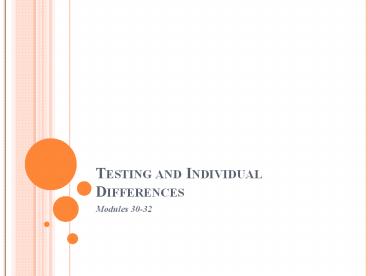Testing and Individual Differences - PowerPoint PPT Presentation
1 / 24
Title:
Testing and Individual Differences
Description:
TESTING AND INDIVIDUAL DIFFERENCES Modules 30-32 MEASURING INDIVIDUAL DIFFERENCES Psychology relies heavily on testing individuals, it is part of the foundation for ... – PowerPoint PPT presentation
Number of Views:276
Avg rating:3.0/5.0
Title: Testing and Individual Differences
1
Testing and Individual Differences
- Modules 30-32
2
Measuring Individual Differences
- Psychology relies heavily on testing individuals,
it is part of the foundation for psychological
analysis. To be effective, however, strict
guidelines must be followed. - Validity Does the test actually measure what we
say it does/what we want it to? - Ex. Reading on a math test
- Face validity Does the test look like it tests
what it is supposed to test? - Content validity Each part of the test is
representative of the larger body of knowledge.
3
Measuring Individual Differences
- Criterion Validity The behavior (such as college
grades) that a test (such as the SAT) is designed
to predict - Predictive Validity The success with which a
test predicts the behavior it is designed to
predict.
4
Assessing Intelligence
- As the range of data under consideration narrows,
its predictive power diminishes
5
Measuring Individual Differences
- The second part of a credible test is
reliability. - Reliability A test yields the same results over
time - Test-Retest or Split-Half Reliability
Reliable, but not valid
Not reliable, not valid
Reliable and valid
6
Creating Validity and Reliability
- The most efficient way to create validity and
reliability is to use a standardized test. - In the most basic sense, a standardized test
means - The administration and scoring is the same for
each test - The results of the test can be used to draw a
conclusion about the test takers in regard to the
objectives of the test. - Ex. AP test, S.A.T.
7
Judging Normal
- A normal curve is applied to test to determine
establish norms. When a statistically
significant sample of the population has been
tested, strong conclusions can be drawn. - A normal range for IQ scores is 70-130. Scores
below 70 indicate mental retardation while scores
above 130 are considered gifted.
8
Normal Distribution of IQ Scores
9
Degrees of Mental Retardation
10
Types of Tests
- There are two main types of tests
- Objective Tests Tests that have one set answer,
that can be scored easily by machine - Ex. Multiple choice
- Subjective Tests Tests in which individuals are
given ambiguous figures or an open ended question
which requires some interpretation and analysis. - Ex. FRQs
- Inter-rater reliability
11
Sample Subjective Test
- The Rorschach Inkblot Test is one of the most
widely known, and inaccurate subjective tests. - The following slides are real inkblots from the
test that was, at one time, a widely used test.
Today, it has lost much, if not all of its
credibility in determining intelligence or mental
illness.
12
(No Transcript)
13
(No Transcript)
14
(No Transcript)
15
Intelligence Testing
- A term that is used frequently, but often
misunderstood is intelligence. What exactly is
intelligence? - Many people disagree about what exactly
intelligence is, but most do agree that it is - Relative defined in relation to the same
abilities in a comparison group (usually age) - Hypothetically constructed it is unobservable,
but instead inferred from behavior
16
Testing IQ
- IQ (intelligence quotient) became a popular way
to classify people in the early 1900s when two
French psychologists (Alfred Binet and Theodore
Simon) developed a test to identify those
students who were gifted, and those who needed
extra help.
17
Binet-SimonTest
- The test had four important distinctions
- Scores were interpreted at their current
performance - Used to identify students in need of help, not
label them or categorize them - Emphasized that training and opportunity could
affect intelligence - Was empirically constructed
- Scoring the test was done by calculating the
mental age (MA) and the chronological age (CA). - MA The average age at which normal individuals
achieve a particular score - CA The number of years since an individuals
birth
18
Coming to America
- The idea of IQ testing became popular in America
for three reasons - A huge increase in immigration
- New laws requiring universal education
- Military assessing new recruits for WWI
- It created an inexpensive and objective way to
separate those could benefit from education or
military leadership training and those who needed
assistance.
19
Downside of IQ Testing
- Despite its utility, IQ testing had a big
downside. Tests ended up reinforcing prevailing
prejudices about race and gender. - Ignored was the fact that environmental
disadvantages limit the full development of
peoples intellectual abilities.
20
Stanford-Binet Intelligence Scale
- When the Binet test was adopted by a Stanford
professor, he changed the equation to make
intelligence scores into non-decimal numbers.
This now became known as the Intelligence
Quotient (IQ).
IQ
21
Components of Intelligence
- Savant Syndrome Individuals with remarkable, but
rare talent, even though they are mentally
deficient in other areas. - Ex. Dustin Hoffman in Rain Man
22
Theories of Intelligence
- Spearmans g Factor Charles Spearman thought
intelligence was a general factor behind all of
our mental ability. - Sternbergs Triarchic Theory (CAP)
- Catells Fluid and Crystallized Intelligence
- The g factor
23
Theories of Intelligence
- Howard Gardner believed that IQ scores measured
only a limited range of human mental abilities.
He argued we have seven separate mental abilities
he calls the multiple intelligences. - Linguistic intelligence ("word smart")
- Logical-mathematical intelligence
("number/reasoning smart") - Spatial intelligence ("picture smart")
- Bodily-Kinesthetic intelligence ("body smart")
- Musical intelligence ("music smart")
- Interpersonal intelligence ("people smart")
- Intrapersonal intelligence ("self smart")
24
(No Transcript)

